|
Philosophers
Mortimer Adler Rogers Albritton Alexander of Aphrodisias Samuel Alexander William Alston Anaximander G.E.M.Anscombe Anselm Louise Antony Thomas Aquinas Aristotle David Armstrong Harald Atmanspacher Robert Audi Augustine J.L.Austin A.J.Ayer Alexander Bain Mark Balaguer Jeffrey Barrett William Barrett William Belsham Henri Bergson George Berkeley Isaiah Berlin Richard J. Bernstein Bernard Berofsky Robert Bishop Max Black Susanne Bobzien Emil du Bois-Reymond Hilary Bok Laurence BonJour George Boole Émile Boutroux Daniel Boyd F.H.Bradley C.D.Broad Michael Burke Jeremy Butterfield Lawrence Cahoone C.A.Campbell Joseph Keim Campbell Rudolf Carnap Carneades Nancy Cartwright Gregg Caruso Ernst Cassirer David Chalmers Roderick Chisholm Chrysippus Cicero Tom Clark Randolph Clarke Samuel Clarke Anthony Collins Antonella Corradini Diodorus Cronus Jonathan Dancy Donald Davidson Mario De Caro Democritus Daniel Dennett Jacques Derrida René Descartes Richard Double Fred Dretske John Earman Laura Waddell Ekstrom Epictetus Epicurus Austin Farrer Herbert Feigl Arthur Fine John Martin Fischer Frederic Fitch Owen Flanagan Luciano Floridi Philippa Foot Alfred Fouilleé Harry Frankfurt Richard L. Franklin Bas van Fraassen Michael Frede Gottlob Frege Peter Geach Edmund Gettier Carl Ginet Alvin Goldman Gorgias Nicholas St. John Green H.Paul Grice Ian Hacking Ishtiyaque Haji Stuart Hampshire W.F.R.Hardie Sam Harris William Hasker R.M.Hare Georg W.F. Hegel Martin Heidegger Heraclitus R.E.Hobart Thomas Hobbes David Hodgson Shadsworth Hodgson Baron d'Holbach Ted Honderich Pamela Huby David Hume Ferenc Huoranszki Frank Jackson William James Lord Kames Robert Kane Immanuel Kant Tomis Kapitan Walter Kaufmann Jaegwon Kim William King Hilary Kornblith Christine Korsgaard Saul Kripke Thomas Kuhn Andrea Lavazza James Ladyman Christoph Lehner Keith Lehrer Gottfried Leibniz Jules Lequyer Leucippus Michael Levin Joseph Levine George Henry Lewes C.I.Lewis David Lewis Peter Lipton C. Lloyd Morgan John Locke Michael Lockwood Arthur O. Lovejoy E. Jonathan Lowe John R. Lucas Lucretius Alasdair MacIntyre Ruth Barcan Marcus Tim Maudlin James Martineau Nicholas Maxwell Storrs McCall Hugh McCann Colin McGinn Michael McKenna Brian McLaughlin John McTaggart Paul E. Meehl Uwe Meixner Alfred Mele Trenton Merricks John Stuart Mill Dickinson Miller G.E.Moore Ernest Nagel Thomas Nagel Otto Neurath Friedrich Nietzsche John Norton P.H.Nowell-Smith Robert Nozick William of Ockham Timothy O'Connor Parmenides David F. Pears Charles Sanders Peirce Derk Pereboom Steven Pinker U.T.Place Plato Karl Popper Porphyry Huw Price H.A.Prichard Protagoras Hilary Putnam Willard van Orman Quine Frank Ramsey Ayn Rand Michael Rea Thomas Reid Charles Renouvier Nicholas Rescher C.W.Rietdijk Richard Rorty Josiah Royce Bertrand Russell Paul Russell Gilbert Ryle Jean-Paul Sartre Kenneth Sayre T.M.Scanlon Moritz Schlick John Duns Scotus Arthur Schopenhauer John Searle Wilfrid Sellars David Shiang Alan Sidelle Ted Sider Henry Sidgwick Walter Sinnott-Armstrong Peter Slezak J.J.C.Smart Saul Smilansky Michael Smith Baruch Spinoza L. Susan Stebbing Isabelle Stengers George F. Stout Galen Strawson Peter Strawson Eleonore Stump Francisco Suárez Richard Taylor Kevin Timpe Mark Twain Peter Unger Peter van Inwagen Manuel Vargas John Venn Kadri Vihvelin Voltaire G.H. von Wright David Foster Wallace R. Jay Wallace W.G.Ward Ted Warfield Roy Weatherford C.F. von Weizsäcker William Whewell Alfred North Whitehead David Widerker David Wiggins Bernard Williams Timothy Williamson Ludwig Wittgenstein Susan Wolf Scientists David Albert Michael Arbib Walter Baade Bernard Baars Jeffrey Bada Leslie Ballentine Marcello Barbieri Gregory Bateson Horace Barlow John S. Bell Mara Beller Charles Bennett Ludwig von Bertalanffy Susan Blackmore Margaret Boden David Bohm Niels Bohr Ludwig Boltzmann Emile Borel Max Born Satyendra Nath Bose Walther Bothe Jean Bricmont Hans Briegel Leon Brillouin Stephen Brush Henry Thomas Buckle S. H. Burbury Melvin Calvin Donald Campbell Sadi Carnot Anthony Cashmore Eric Chaisson Gregory Chaitin Jean-Pierre Changeux Rudolf Clausius Arthur Holly Compton John Conway Simon Conway-Morris Jerry Coyne John Cramer Francis Crick E. P. Culverwell Antonio Damasio Olivier Darrigol Charles Darwin Richard Dawkins Terrence Deacon Lüder Deecke Richard Dedekind Louis de Broglie Stanislas Dehaene Max Delbrück Abraham de Moivre Bernard d'Espagnat Paul Dirac Hans Driesch John Dupré John Eccles Arthur Stanley Eddington Gerald Edelman Paul Ehrenfest Manfred Eigen Albert Einstein George F. R. Ellis Hugh Everett, III Franz Exner Richard Feynman R. A. Fisher David Foster Joseph Fourier Philipp Frank Steven Frautschi Edward Fredkin Augustin-Jean Fresnel Benjamin Gal-Or Howard Gardner Lila Gatlin Michael Gazzaniga Nicholas Georgescu-Roegen GianCarlo Ghirardi J. Willard Gibbs James J. Gibson Nicolas Gisin Paul Glimcher Thomas Gold A. O. Gomes Brian Goodwin Joshua Greene Dirk ter Haar Jacques Hadamard Mark Hadley Patrick Haggard J. B. S. Haldane Stuart Hameroff Augustin Hamon Sam Harris Ralph Hartley Hyman Hartman Jeff Hawkins John-Dylan Haynes Donald Hebb Martin Heisenberg Werner Heisenberg Grete Hermann John Herschel Basil Hiley Art Hobson Jesper Hoffmeyer Don Howard John H. Jackson William Stanley Jevons Roman Jakobson E. T. Jaynes Pascual Jordan Eric Kandel Ruth E. Kastner Stuart Kauffman Martin J. Klein William R. Klemm Christof Koch Simon Kochen Hans Kornhuber Stephen Kosslyn Daniel Koshland Ladislav Kovàč Leopold Kronecker Rolf Landauer Alfred Landé Pierre-Simon Laplace Karl Lashley David Layzer Joseph LeDoux Gerald Lettvin Gilbert Lewis Benjamin Libet David Lindley Seth Lloyd Werner Loewenstein Hendrik Lorentz Josef Loschmidt Alfred Lotka Ernst Mach Donald MacKay Henry Margenau Owen Maroney David Marr Humberto Maturana James Clerk Maxwell Ernst Mayr John McCarthy Warren McCulloch N. David Mermin George Miller Stanley Miller Ulrich Mohrhoff Jacques Monod Vernon Mountcastle Emmy Noether Donald Norman Travis Norsen Alexander Oparin Abraham Pais Howard Pattee Wolfgang Pauli Massimo Pauri Wilder Penfield Roger Penrose Steven Pinker Colin Pittendrigh Walter Pitts Max Planck Susan Pockett Henri Poincaré Daniel Pollen Ilya Prigogine Hans Primas Zenon Pylyshyn Henry Quastler Adolphe Quételet Pasco Rakic Nicolas Rashevsky Lord Rayleigh Frederick Reif Jürgen Renn Giacomo Rizzolati A.A. Roback Emil Roduner Juan Roederer Jerome Rothstein David Ruelle David Rumelhart Robert Sapolsky Tilman Sauer Ferdinand de Saussure Jürgen Schmidhuber Erwin Schrödinger Aaron Schurger Sebastian Seung Thomas Sebeok Franco Selleri Claude Shannon Charles Sherrington Abner Shimony Herbert Simon Dean Keith Simonton Edmund Sinnott B. F. Skinner Lee Smolin Ray Solomonoff Roger Sperry John Stachel Henry Stapp Tom Stonier Antoine Suarez Leo Szilard Max Tegmark Teilhard de Chardin Libb Thims William Thomson (Kelvin) Richard Tolman Giulio Tononi Peter Tse Alan Turing C. S. Unnikrishnan Nico van Kampen Francisco Varela Vlatko Vedral Vladimir Vernadsky Mikhail Volkenstein Heinz von Foerster Richard von Mises John von Neumann Jakob von Uexküll C. H. Waddington James D. Watson John B. Watson Daniel Wegner Steven Weinberg Paul A. Weiss Herman Weyl John Wheeler Jeffrey Wicken Wilhelm Wien Norbert Wiener Eugene Wigner E. O. Wilson Günther Witzany Stephen Wolfram H. Dieter Zeh Semir Zeki Ernst Zermelo Wojciech Zurek Konrad Zuse Fritz Zwicky Presentations Biosemiotics Free Will Mental Causation James Symposium |
Heating System for the Information Philosophy Institute
Heating Plan (October 17, 2018)
For overall plans, see informationphilosopher.com/institute/plans/
Two new gas meters are rated at 250 cu.ft. per hour. But Eversource says they can handle 375K cu.ft./hr. At 1000 BTU/cu.ft., we have plenty of input. But we still might want to upgrade the meter to 1.5-inch (now 1 inch)
We are installing the Burnham Aspen ASPN-270 rather than the recommended Alpine 270 model. It has a modulation turndown of 10/1 (Alpine is 5/1). The ASPN-270 is much lighter and wall mountable and its output is 253K BTHh compared to the Alpine 229K. Aspen models have SAGE 2.3
The system flue gases vent out and fresh combustion air comes in through the driveway-side wall, using a Diversitech HVent.
The Aspen brochure looks great. It shows the supply, return, and condensate trap exiting the bottom. Wall mounting is great because I want the control panel up at eye level. And the extra height means the condensate drain might not need a pump.
The Aspen comes with a wired or wireless outdoor air temperature sensor. .
We will use 4 programmable wired thermostats with SAGE Zone Control for the three upper floors and the basement.
To manage the boiler return temperature we need thermometers on the individual zone returns. We accomplish this with four TACO Viridian VT2218 flow circulators, which display supply and return temperatures. The garage zone will use a TACO 007 Circulator. A second SZC is needed for the garage zone.
Twenty-one new European style, white, wall-mounted radiators will be installed on the upper three floors. List below
We started to run Wirsbo/Uponor AquaPEX (PEX-A) piping to the first few radiators we installed, then we were told we need hePEX with oxygen barriers! We pulled out the AquaPEX and replaced it with hePEX. At this time, 6 of the 21 upper-floor home runs are in place and three radiators are mounted..
We hope to hide all PEX heating pipes up between joists and down inside wall partitions in the basement.
We will replace the hot water heater with an indirect storage tank connected to the boiler by a heat exchanger, but keep the old GE hot water heater running until the new system is up and running.
We considered the Burnham Alliance indirect tank, a branded version of the very heavy HydraStone tank built by Vaughn (over 300 lbs.). Vaughn's attractive new Featherweight uses the same layers of oxygen trapping as the heavy models. The Vaughn Featherweight 55F is probably the best fit. It is somewhat large at 28" diameter, but weighs only 95 lbs.
We have been trying to understand the Burnham boiler control system, called SAGE 2.3, and how it works with zone thermostats, with system zone circulators.
Partial Parts List
Heating Load Calculations (September 26, 2018)
We are replacing two old steam boilers, a 150K Weil-McLean installed in 1977 and a 250K installed in 1997. Assuming those boilers were running at 50% efficiency compared to today's mod-con models, we thought we need at least 150K BTU/hr.
We used two online heating load calculation programs (one was CoolCalc), which included all the rooms with their exposed walls, ceilings, floors, etc. They also put us in the 150K neighborhood for the three upper floors.
Another way was to get the BTU/hr needed was to look at my past Eversource gas bills.
Last January the gas supplied was 681 therms. At 100,000 BTU/therm, that is 68,100,000 BTU over 30 days per month and 24 hours a day gives us about 95K BTU/hr.
The average temperature of a January is 29°F (day 36°F, night 22°F). On a cold night, the difference between OAT and interior is say 72°F.
So the average difference that month was 43°F, and the extreme difference is 72°F I think that means we need 72/43 times 95K or 159K BTU/hr to cover the coldest days. And this was for only the three upper floors. We now need to heat a renovated basement an a one-room garage.
There is no insulation in our wooden walls. We have added several large windows and sliding glass patio doors. The original 45 windows now have modern e-glass storms.
We list the different numbers of segments in the old steam radiators, and proposed BTU/hr capacity of new panel radiators.
Panel radiator (advertised/nominal) ratings below are quoted for 180° supply temperature. Most quotes are for temperature drop ΔT =20°F with 65° air. At 140° supply, to get the actual capacity needed we should derate the BTU/hr to 65% (ECOstyle), 57% (Runtal)?
The latest proposed boiler (Burnham Aspen ASPN-270) is rated at 252,000 BTU/ hr output. That can easily supply heat to all five zones. The basement and garage zones will need less than the upper floors. The boiler should probably derated for 140°F supply to 130K BTU/hr and even further for 120°F supply?
Because hydronic panels are modulated to run continuously, we assume that only a fraction of the steam radiators BTU/hr will be needed except for very cold winter nights.
Upper floors
Each bedroom has two windows totaling 28.5 sq.ft.Floor areas are: Front BR: 137.5 sq. ft. (5 segments, 4000 BTU) Middle: BR 121 sq. ft. (5 segments, 4000 BTU) Rear BR: 132 sq. ft. (5 segments, 4000 BTU) We ordered a 36"(H) x 24"(W) Ecostyle (nominal 10,240 BTU at 180°F) to test Bath window is 7 sq.ft. Floor area 40 sq.ft. (3 segments, 2000 BTU) Large double LR/dining (my conference room on first floor). Floor area: 400 sq.ft. (16 segments, 12,000 BTU, e.g, Windows 2x14.2 + 2x10.2 + 34 = 82.8 sq.ft. Buderus 21, 24" x 71" 123 lbs, $598 Ecostyle B-24.64 - 12138/7337 BTU - 24" x 64", 118lbs, $549 We ordered a 24"(H) x 71"(W) Buderus (nominal 10,240 BTU at 180°F) to test Kitchen: Floor area: 308 sq.ft. (12 segments, 9,000 BTU) Windows: 40.3 (bay) + 34.5 (sliding door) = 74.8 sq.ft. The first floor is different: Conference room has no bay window: so windows = 42.5 sq.ft. Area still 400 sq.ft. (12 segments, 9,000 BTU) Green room has a pantry and back hall, so floor area is reduced to 168 sq,ft. It has two 14.2 windows = 28.4 sq.ft. (6 segments, 5000 BTU) 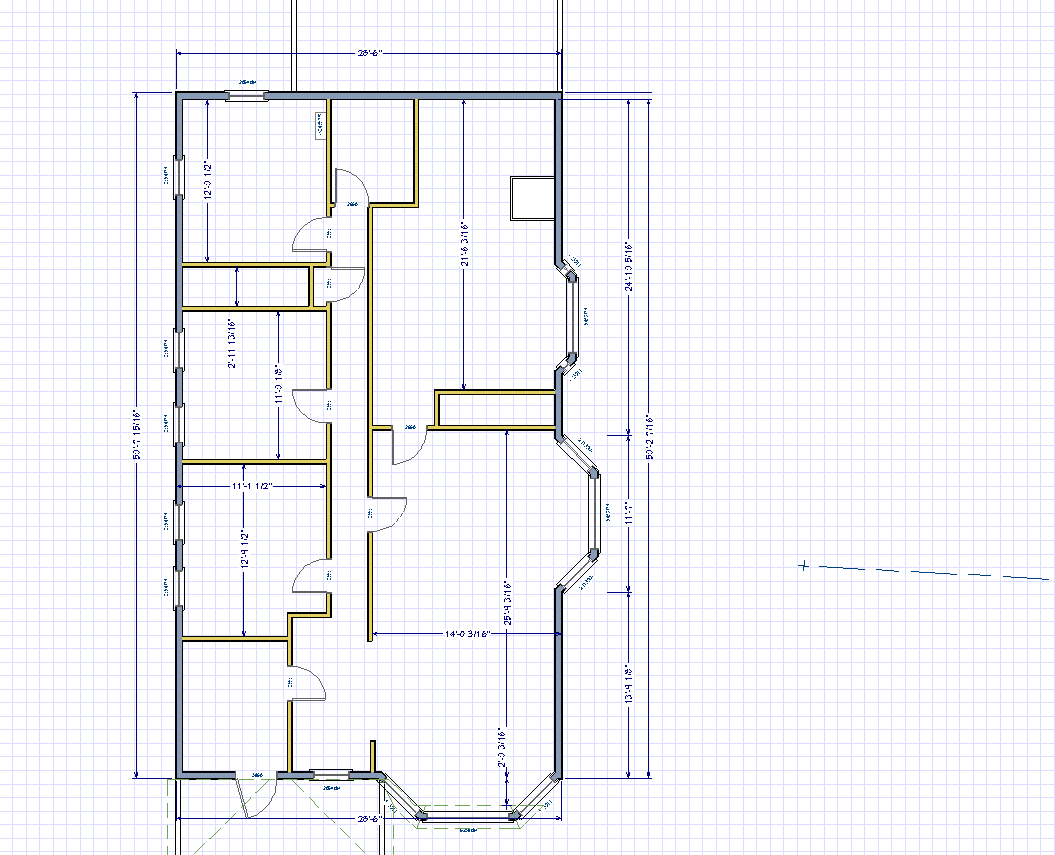
Basement
Basement offices each have one small 4.5 sq. ft. window. Below ground stays relatively cool in summer, and moderately warm in winter. It will be heated by about 20 PEX pipes in the corridor ceiling and the boiler room.
Office 1: 176 sq.ft. (4000 BTU)Office 2: 120 sq.ft.(4000 BTU) Bathroom: 42 sq.ft., no window (2000 BTU). 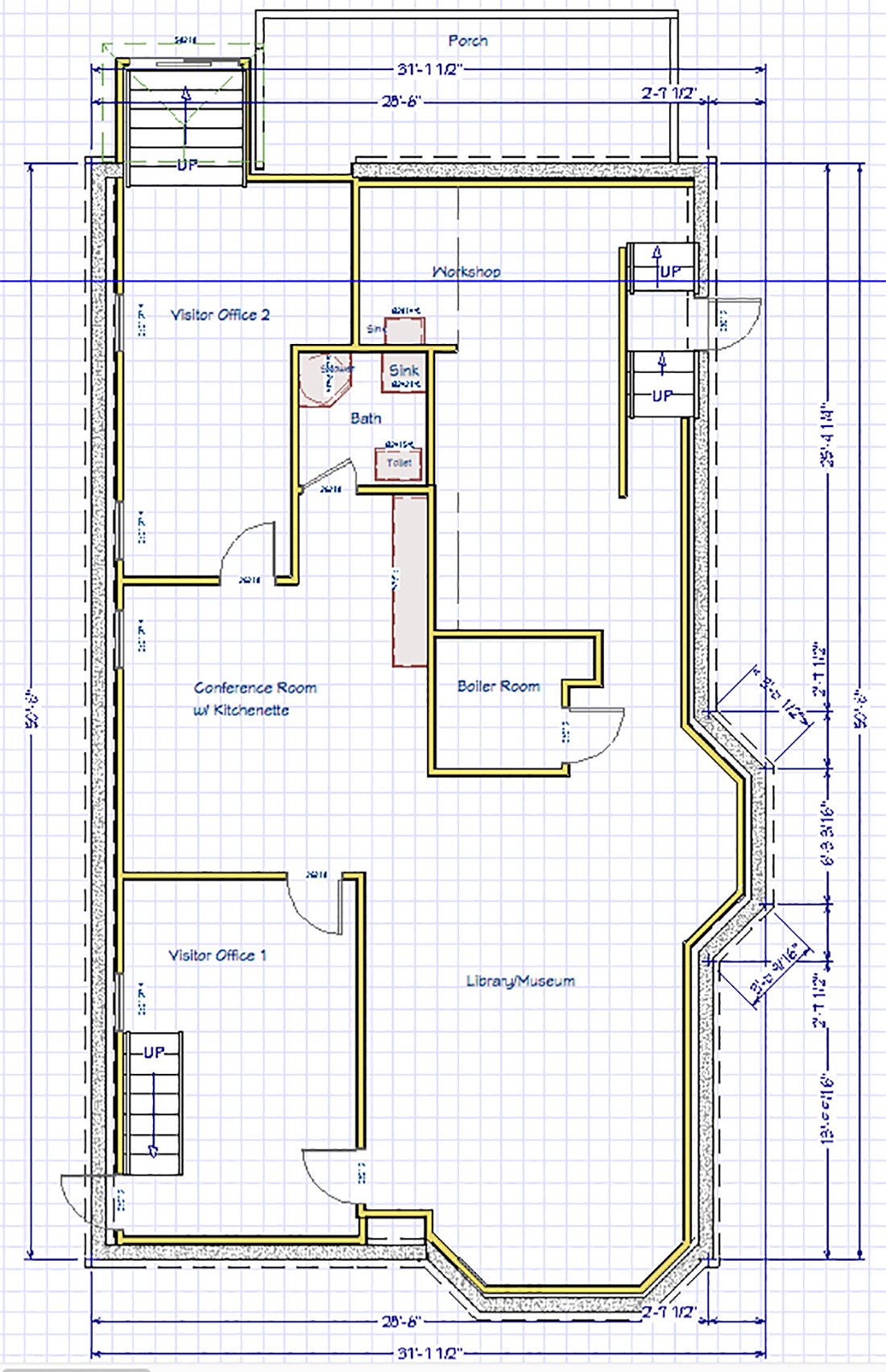
Garage
The garage is one room, ~300 sq. ft., no insulation and a very leaky door. It has two Dimplex DGWH4031 4000-Watt Garage/Workshop Heaters. They each generate 13K BTU/hr, and warm the garage quickly to 70° on very cold days. So the garage might get by with 10K BTU/hr, though it would not heat up as quickly?
Panel radiators (October 1, 2018)
We researched four brands of panel radiators, Buderus (Bosch/Germany), ECOstyle (Biasi/Italy), Pensotti (Granby/Italy-Turkey), and Runtal (Switzerland).
Some are equipped with flow valve regulators, some with thermostatic control valves, some have side and bottom connections, most are 4 inches deep, some only 2.5 inches (these less efficient)
We decided on 17 Buderus readiatos and two ECOstyle units, because of their 36" x 24" shape.
Purchased radiators (October 17, 2018)
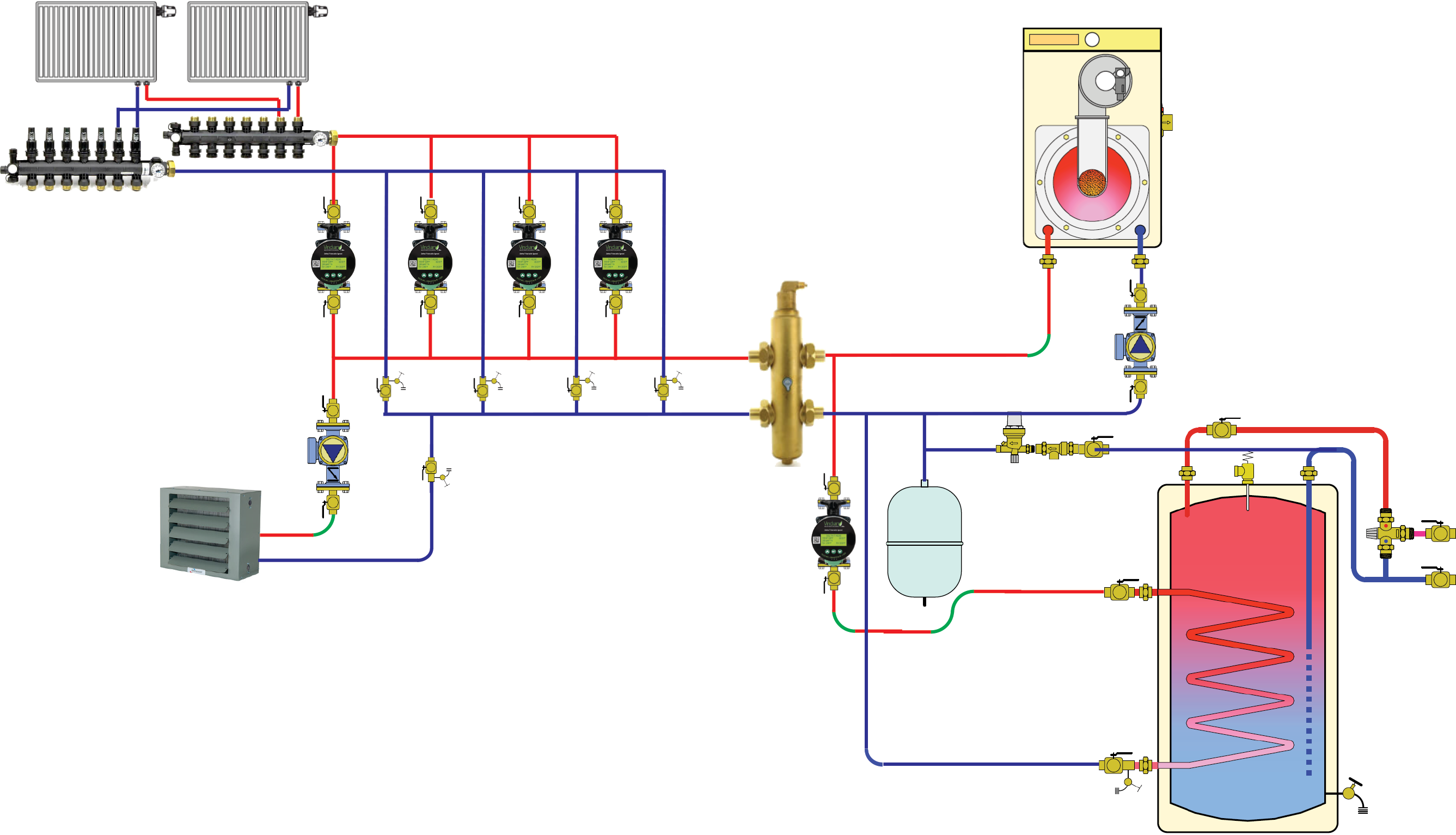 Installation Mostly Completed as of October 18. (Right-click the image to open full size.)
Installation Mostly Completed as of October 18. (Right-click the image to open full size.)
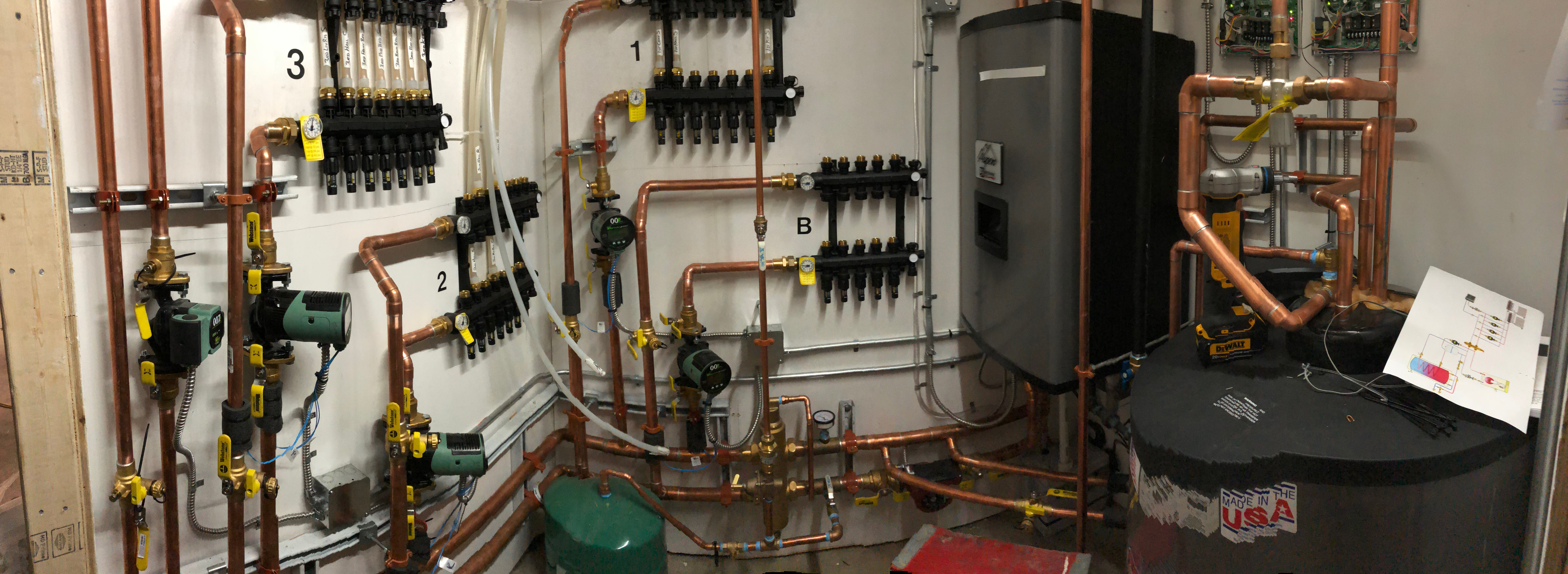
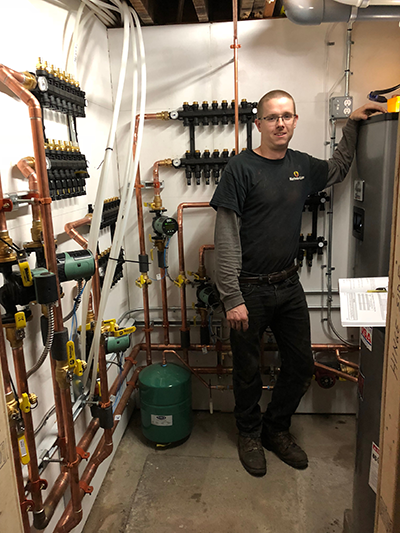 Joe Forde with PEX to one radiator installed
Joe Forde with PEX to one radiator installed
|